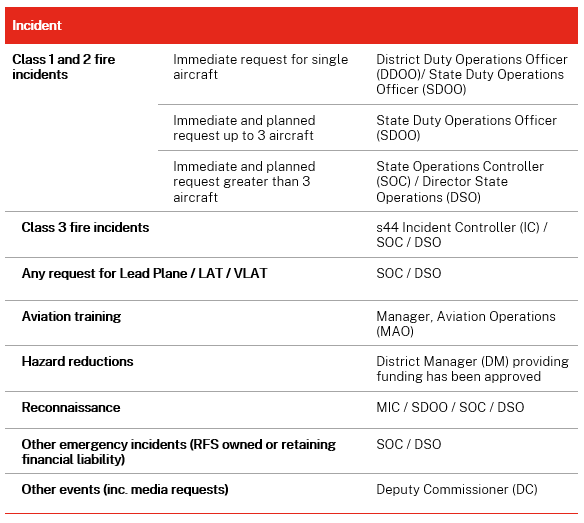Aircraft / Aviation Equipment Request
IMT
Scope
This Operational Guideline outlines the requirements for requesting aircraft/aviation equipment for incidents, hazard reductions, reconnaissance, training, or other events.
Fundamental Protocols underpin the actions of all NSW Rural Fire Service (RFS) members and must be adhered to at all times. They outline the Principles of being an RFS member and provide guidance on conduct to support the safety and wellbeing of members.
Guiding Principles
- The State Air Desk (SAD) will only dispatch resources that have been requested and approved on an Aircraft/Aviation Equipment Request Form.
- Where a need is identified for aircraft/aviation equipment, a strategy must be developed in support of the request in ICON, to ensure the most effective and economical use.
- The request should include aircraft as well as any support requirements such as specialist equipment, refuelling, and mixing/loading capability.
- All requests must be approved by a person with appropriate authority as outlined in this Operational Procedure and Guideline (OPG). The ongoing requirement to retain or release aircraft/aviation equipment is outlined in the RFS OPG - Resource Retain/Release Procedure and does not form part of the scope of this OPG.
- The urgency of the request needs to be clearly documented and will subsequently inform the dispatch decision. The urgency of the task can be either:
- Immediate – where there is an urgent need for the resource. In this situation the requested resource with the fastest response time to the incident will be dispatched; or
- Planned – where there is no urgency to the requirement (such as where an immediate request is not warranted and the situation at hand can accommodate a later arriving resource, or when the request is for a subsequent day), the most cost effective resource will be dispatched.
- Any immediate dispatch will be for a single day only. Any ongoing requirement for such a resource will need to be documented on the RFS OPG - Resource Retain/Release form and will be subject to a planned dispatch for subsequent days.
- Any planned dispatch must have an end date stipulated. The request can be up to 5 days (subject to ongoing daily review) with justification required for any extension beyond a single day. All dispatches will need to be evaluated daily and further advice provided in the retain/release documentation for ongoing requirement/s.
- Any request needs to clearly indicate the number and type of resource/s required relevant to the documented strategy. Requests will also need to include consideration for:
- Any specialist equipment such as Forward Looking Infrared (FLIR), Winch, Aerial Incendiary (AI), belly tank, etc.
- The refuelling requirements – including whether there is a fuel solution at a local airport or if a mobile solution is required to support a forward helibase.
- The location of any firefighting products that may be required.
- Where mixing and loading of aerial firefighting products for fixed wing aircraft is requested, RFS mixing and loading resources should always be sourced as the first option. Contract operators should only be engaged through the SAD where the RFS is not able to provide such capabilities.
- The request must be approved by a person who holds the required authority as outlined in the following table.
Special Considerations
- To minimise delay for an immediate/urgent request, 1 aircraft can be approved by the District Duty Officer. Any greater response will need further escalation and approval.
- Some aircraft are contracted with mobile fuel solutions. The SAD will be able to assist with providing advice if the resource selected by ARENA for dispatch includes a self-sufficient fuel solution or not.
- Where there is significant demand for aviation resources, requests will be triaged according to threats. Incidents with greater threats will receive priority for aviation resources. Triaging will be undertaken by the SOC / DSO.
- Due to the ad hoc nature of contract arrangements outside of fire season, there is potential that a request may be delayed or modified due to lack of resource availability.
- Where a relevant approving party is not able to physically sign the request form, an approval email is acceptable and should be attached to the request form and documented in the signatory box that an email approval is attached.
- If you are considering the use of Night Operations (NVIS), discuss with the SAD the potential for such capability and any limitations. It is likely that any requirement for NVIS will need advanced notification.
- Transportation of any personnel to and from an incident by aircraft tasked by the SAD must be approved by either SOC / SDOO / DSO.
Related Information
Content Owner: Aviation
Date Approved: 18 Dec 2024
Review Required: 18 Dec 2027
Version: 1.0
If you have any questions or feedback on Operational Doctrine, please email Ops.Performance@rfs.nsw.gov.au.




